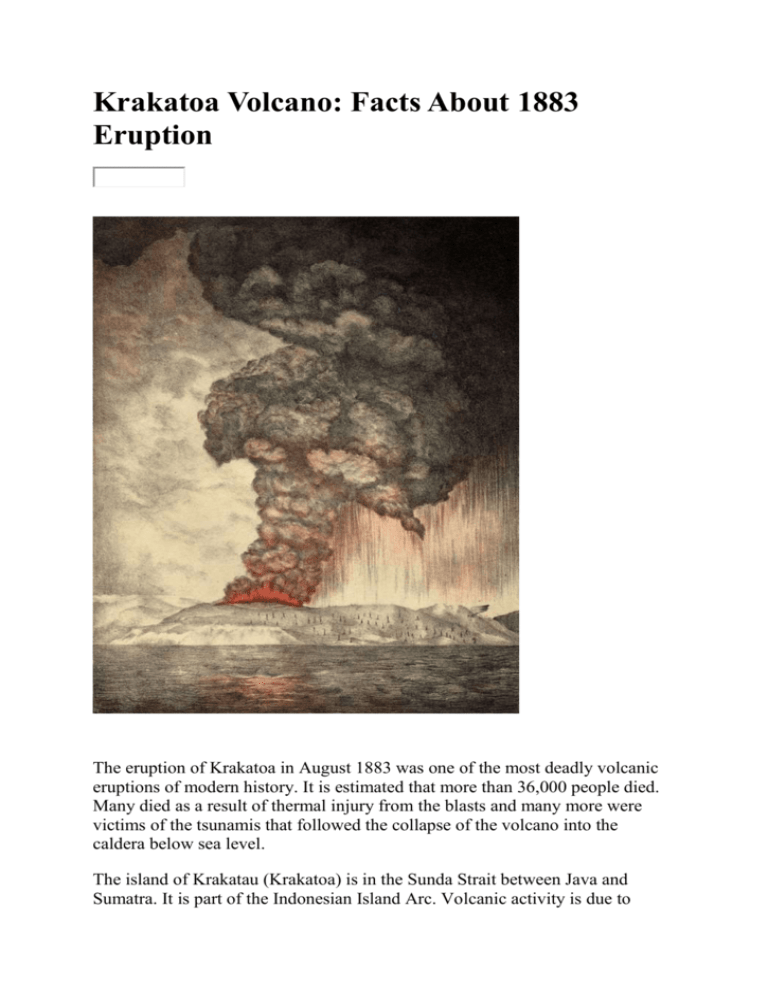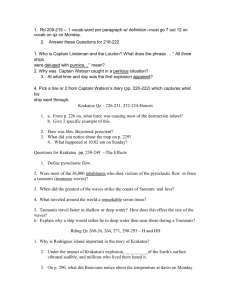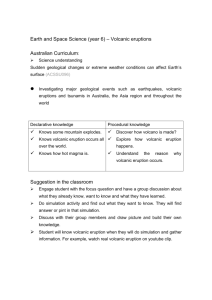Krakatoa - Global2
advertisement

Krakatoa Volcano: Facts About 1883 Eruption The eruption of Krakatoa in August 1883 was one of the most deadly volcanic eruptions of modern history. It is estimated that more than 36,000 people died. Many died as a result of thermal injury from the blasts and many more were victims of the tsunamis that followed the collapse of the volcano into the caldera below sea level. The island of Krakatau (Krakatoa) is in the Sunda Strait between Java and Sumatra. It is part of the Indonesian Island Arc. Volcanic activity is due to subduction of the Indo-Australian tectonic plate as it moves northward towards mainland Asia. The island is about 3 miles wide and 5.5 miles long (9 by 5 kilometers). Before the historic eruption, it had three linked volcanic peaks: Perboewatan, the northernmost and most active; Danan in the middle; and the largest, Rakata, forming the southern end of the island. Krakatau and the two nearby islands, Lang and Verlatan, are remnants of a previous large eruption that left an undersea caldera between them. In May 1883, the captain of the Elizabeth, a German warship, reported seeing clouds of ash above Krakatau. He estimated them to be more than 6 miles (9.6 km) high. For the next two months, commercial vessels and chartered sightseeing boats frequented the strait and reported thundering noises and incandescent clouds. People on nearby islands held festivals celebrating the natural fireworks that lit the night sky. Celebration would come to a tragic halt on Aug. 27. At 12:53 p.m. on Sunday the 26th, the initial blast of the eruption sent a cloud of gas and debris an estimated 15 miles (24 km) into the air above Perboewatan. It is thought that debris from the earlier eruptive activity must have plugged the neck of the cone, allowing pressure to build in the magma chamber. On the morning of the 27th, four tremendous explosions, heard as far away as Perth, Australia, some 2,800 miles (4,500 km) distant, plunged both Perboewatan and Danan into the caldera below the sea. The initial explosion ruptured the magma chamber and allowed sea water to contact the hot lava. The result is known as a phreatomagmatic event. The water flash-boiled, creating a cushion of superheated steam that carried the pyroclastic flows up to 25 miles (40 km) at speeds in excess of 62 mph (100 kph). The eruption has been assigned a rating of 6 on the Volcanic Explosion Index and is estimated to have had the explosive force of 200 megatons of TNT. (For purposes of comparison, the bomb that devastated Hiroshima had a force of 20 kilotons. The Mount St. Helens explosion of 1980 had a VEI of 5.) Tephra and hot volcanic gases overcame many of the victims in western Java and Sumatra, but thousands more were killed by the devastating tsunami. The wall of water, nearly 140 feet tall, was created by the volcanoes’ collapse into the sea. It completely overwhelmed small nearby islands. Inhabitants of the coastal towns on Java and Sumatra fled toward higher ground, fighting their neighbors for toeholds on the cliffs. The steamship Berouw was carried nearly a mile inland on Sumatra; all 28 crewmembers were killed. Another ship, the Loudon, had been anchored nearby. The ship's captain Lindemann succeeded in turning its bow to face the wave and the ship was able to ride over the crest. Looking back, the crew and passengers saw that nothing was left of the pretty town where they had been anchored. The explosions hurled an estimated 11 cubic miles (45 cubic km) of debris into the atmosphere darkening skies up to 275 miles (442 km) from the volcano. In the immediate vicinity, the dawn did not return for three days. Barographs around the globe documented that the shock waves in the atmosphere circled the planet at least seven times. Within 13 days, a layer of sulfur dioxide and other gases began to filter the amount of sunlight able to reach Earth. The atmospheric effects made for spectacular sunsets all over Europe and the United States. Average global temperatures were up to 1.2 degrees cooler for the next five years. Tasks- Please note 1. Krakatoa’s explosion hurled 45 cubic kilometres of ash into the atmosphere. a) Describe what a cubic kilometre would look like. b) Change a cubic km into cubic metres.(Show your working out) c) Change 45 cubic kilometres in cubic metres 2. Shock waves from the Krakatoa explosion circulated the earth at least 7 times. a) What distance is this? (Show your working out) b) Change this distance to metres. c) If you drove your car at 100kph how long would you take to cover this distance. 3. The Krakatoa eruption was heard as far away as Perth (4,500km ) away. Google the speed of sound. Calculate the time between the actual explosion of Krakatoa and when the people in Perth heard it? Show working out. Write this answer three waysa) seconds b) minutes c) hours. 4. The Krakatoa tsunami was 140 ft in height. a) Change this to metres. b) How many times your height is this figure. 5. Use excel to graph the size of the Krakatoa explosion compared to other famous eruptions such as Mount St Helens 1980, Mount Vesuvius 79 A.D and TamboraIndonesia 1815.











